- Home
- Support
- Pneumatics
- All About Air Compressors
All About Air Compressors
Overview
Our air powered (pneumatic) props and air blasters require an air compressor to operate. Compressors come in a variety of sizes and specifications. This document will help you to determine the best compressor for your Halloween prop needs.
Common Questions
Let's get the most asked about items out of the way first...
The most common question we get asked is "Can I use more than one prop with a compressor?" The answer is YES! The size of the compressor and types of props being used determines how many props you can run. A manifold, Tee, Y, or other type of splitter is used to branch off to the different props.
"What size compressor do I need?" - again, this depends on the quantity and type of props being used. If you are on a tight budget then a small pancake compressor is fine for 1 to a few props with low air requirements. If you have more to spend then a good all-round compressor choice is one that has at least a 20-gallon holding tank. This will be able to keep up with at least 5 or more props. Keep in mind that air blasters (such as our air blasters) consume a lot of air and will keep a compressor busy. Bottom line: Get the compressor with the largest tank that you can afford.
"What PSI do I need to run my prop at?": We recommend that you use a regulator to set the PSI as low as possible to run the prop. Start low then slowly turn up the pressure until the prop operates as you would like it to. Setting the PSI too high will add more stress and diminish the life of the prop. Too low and it will not function.
Terminology
PSI: Pounds Per Square Inch
This is the amount of air pressure that the compressor can output.
A device called a regulator is used to turn up and down the PSI.
Most compressors have a regulator built right on them. You can also
use additional regulators to control the PSI for each prop or cluster of props.
The majority of Halloween props operate in the 20 to 100 psi range and most air compressors from the smallest to the largest can easily produce this much pressure and so the real deciding factor in selecting the proper size air compressor is the CFM that it can produce and the tank size (see below).
CFM: Cubic Feet per Minute
CFM is the Cubic Feet per Minute that a particular
tool (or in our case a prop) needs to operate.
It is a measurement of volume. Generally the larger the tank on an air
compressor the more CFM it can produce. The more CFM the better because the more volume a compressor
can produce the less it has to work and will be able to keep up with prop air demands.
Lubrication: Oil-Free (or Oil-less)
Some compressors require oil to be added to the engine every so often.
Oil-free means that the compressor does not require this.
Only small compressors are oil-free.
Voltage
The power required to run the compressor. Home outlets are 120volts.
Some garages and warehouses can run 220v compressors.
220v is more efficient but requires a special electrical outlet.
Amps
The amount of power draw a compressor will pull is measured in amps.
If the compressor requires 20amps to operate yet the outlet you put it on can only handle 10amps
then you will blow the breaker. So make sure you plug the compressor into an outlet that can handle it.
Extension cords should not be used with compressors. If you must then make sure that
only very heavy duty extension cords are used.
Tank Size
The larger the air holding tank the less the compressor has to work because there will be
more air available at all times. All things being equal, it is always best to get a
compressor with a larger tank.
Horsepower (HP)
The size of the engine that produces the air. The more HP the quicker the compressor
can make air and has to work less to keep up with multiple props.
Some Compressor Examples
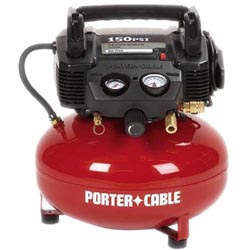 |
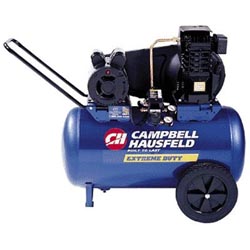 |
| Pancake: Only for a few small props, no air blasters.
|
Horizontal: This is a good choice. Easy to move about and you can get them with 20-gallon or greater tanks.
A 20-gallon or greater tank can easily handle multiple props and air blasters.
|
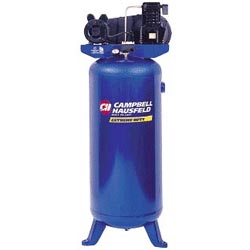 |
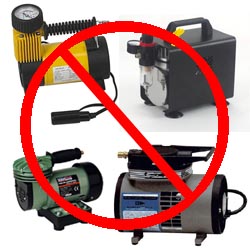 |
| Vertical: Great for permanent locations (such as the corner of a garage). You can get these with large tanks (60-gallon or more) and are highly recommended if you will be running a lot of props.
|
Do not use compressors made for air brush and tire filling. These have small motors and tanks and will not work with props.
|
COMPRESSOR COMPARISON
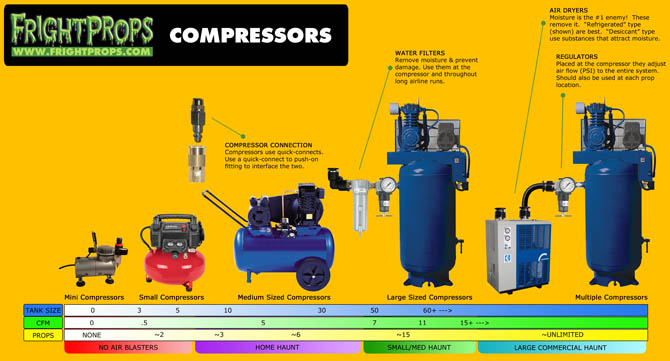
Air Accumulators
Air Accumulators supply a reservoir of air. These are optional but if you are running a lot of props, especially at distances away from each other, they will help to supply air when the props need it.
Click here for accumulators and click here for manifolds.
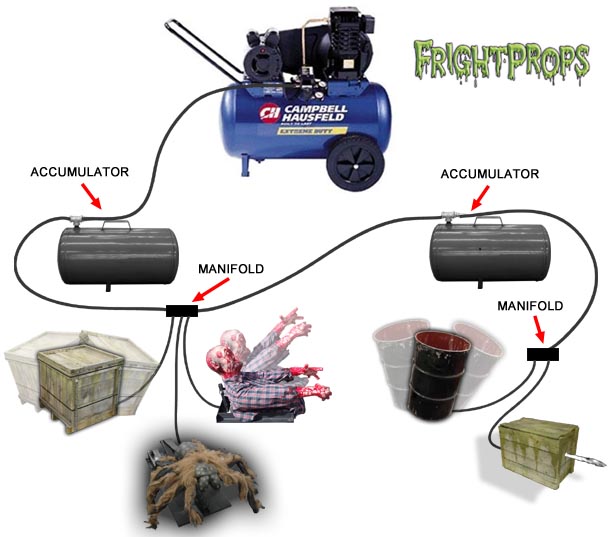
MAINTENANCE TIPS
- Read the Compressor Manual!
- Drain The Moisture From The Tanks: A by-product of compressing air is water. Over time an air compressor tank will fill with water and create rust
- Clean Intake Vents / Filters: A clogged intake/filter means your compressor will work harder and push less air.
- Tighten All Fasteners: Compressors vibrate and shake things loose.
- Check Airline Regularly: Airline leaks make the compressor work harder.
- Test the Safety Shutdown System: This is a fail safe built into the compressor that protects from overheating etc.
- Check and Change the Oil: Compressor oil breaks down over time. Check oil level daily and change per frequency specified in manual (usually every 500-1000 hours of operation).
Where to Buy?
There are numerous places to purchase air compressors. Large home improvement stores such as Home Depot, Lowes, and Menards usually have competitive prices.
These online retailers usually have good prices on compressors:
WARNING: HYDRAULIC AND PNEUMATIC POWER SYSTEMS CAN FAIL THROUGH MISUSE, AGE OR MALFUNCTION. THE SYSTEM DESIGNER IS WARNED TO CONSIDER THE FAILURE MODES OF ALL COMPONENTS USED IN THE DESIGN AND ENGINEERING OF ALL SYSTEMS AND TO PROVIDE ADEQUATE SAFEGUARDS TO PREVENT PERSONAL INJURY OR DAMAGE TO EQUIPMENT IN THE EVENT OF SUCH FAILURES
- Controllers & Electronics
- Pneumatics
- Electric Motors
- Linear Actuators
- Escape Room Tech
- Video & Visual Effects
- Lighting
- Sound & Audio
- Prop Making
- Talking Skulls
- How To Make Stuff
- Electric Firecrackers
- Decorating Supplies
- Foam Filled Props
- Fog, Fluids, Scents
- Customer Service
- Customer Videos & Pics
- Controller Kits
- Other Things


